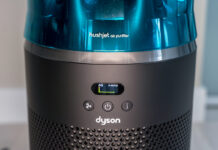 Surface Pro 4: Like the Surface Pro 3, but Thinner and Faster
Surface Pro 4: Like the Surface Pro 3, but Thinner and Faster
Right about the time of the Surface Pro 3, Microsoft seemed to hit the magic formula for its professional tablet. I remember the Surface Pro 3 being the first time I was genuinely impressed with what Microsoft had created. They finally got the display aspect ratio and size right, and the kickstand became dynamically adjustable instead of being limited to one or two positions. It felt as though everything had gelled.
With the fourth generation, Surface Pro 4, Microsoft went with an “if it ain’t broke, don’t fix it” approach and I think that was the right call. So the Surface Pro 4 doesn’t have any major changes from its predecessor, but it does offer a series of improvements and tweaks that make it better than ever.
First, although the overall size remains unchanged at 20.1 cm x 29.2 cm, the Surface Pro 4 is a hair thinner and roughly 12 grams lighter. Is the difference noticeable? Probably not—unless you’re a Surface Pro super fan—but any time you are able to make a large tablet lighter, that’s a good thing. Despite keeping the primary dimensions exactly the same, Microsoft was able to squeeze in a slightly larger display, now 12.3-inches instead of 12-inches. The only victim was the bezel surrounding the display and no-one I know of gets upset about a smaller bezel. The resolution has also been boosted (to 267 ppi from 216 ppi) making the Surface Pro 4’s display extremely sharp. It’s that display that first catches the eye …

Despite being thinner than ever, the Surface Pro gets a larger display and has the ports PS users need, including full-sized USB 3.0
Naturally the CPUs have been updated as well, this round to 6th generation Intel Core processors, ranging from a Core m3 to a Core i7. This adds a little more horsepower while helping to conserve battery life.
One of the bigger changes is with the (sadly) optional Type Cover. Already a pretty cool accessory, the Type Cover for the Surface Pro 4 is stiffer than the Surface Pro 3’s, so there is less typing bounce. The trackpad was also upgraded from plastic to glass and two new options were introduced. Besides the standard Type Cover, a Fingerprint ID keyboard was released (for biometric sign-in) and in recent weeks, the company launched the new Signature Edition Alcantara Type Cover. You can check out my review on the Alcantara cover, which is a great option for adding some exclusive bling to your Surface Pro 4 (or Surface Pro 3).
Surface Pro 4 Key Specs (as tested)
For additional details and configuration options, check out the Surface Pro 4 product page |

Surface Pro 4 User Experience
The Surface Pro 4 is a tablet, but it’s aimed at a professional market. If you want something smaller for casual use—like sitting on the couch and checking Facebook, maybe streaming a video or playing a game—then the Surface 3 is probably the better choice. Or an Apple iPad. Both will save you a fair chunk of change compared to the Surface Pro 4 as well as being much more comfortable to hold in one hand. Don’t get me wrong, you can use the Surface Pro like any other tablet, but at 12.3-inches and weighing 786 grams, it gets heavy, fast.
But if you are a creative professional or someone who goes to a lot of meetings and ends up scribbling notes and diagrams, the combination of the Surface Pro 4 and the included Surface Pen stylus is tough to beat. I attended a Surface Pro session in Toronto last year that was led by a comic book artist and seeing him demonstrate using the stylus and drawing software really drove home how powerful a tool something like this can be in the right hands.
Where the Surface Pro 4 really shines for most users is its ability to transform from tablet into a laptop form factor. To be fair, it doesn’t actually work great sitting on your lap—it’s not quite rigid enough and the kickstand cuts into your legs—but on a desktop or table, the Surface Pro 4 effectively transforms into a portable PC. One that runs Windows 10, regular Windows applications and offers the ability to plug in peripherals like USB hard drives, thumb drives, microSD cards or an external monitor.
The review unit I was using was a mid-range Core i5 model with 4GB of RAM. That was sufficient to run your favourite productivity apps, but with multiple windows and browser tabs open, it started to get a bit sluggish. I’d consider the 8GB RAM option to help avoid that possibility (I would put at least 8GB of RAM in any Windows 10 laptop for that matter) and if you’re going to use a Surface Pro 4 for demanding applications like video editing, the Core i7 CPU is much more powerful and also offers superior Intel Iris graphics.

Battery life for fussing around with applications, web browsing and streaming video was pretty close to the claimed nine hours.
But, you need to invest in the Surface Type Cover to get the most out of this device. I think Microsoft should just include it, even if that means raising the price, but that’s just me.
Who Should Buy It?
If you already own a Surface Pro 3, there’s not a hugely compelling argument for upgrading to the Surface Pro 4. Unless you want an excuse to get a new tablet, in which case go for it. By most measurements, the improvements over the previous generation are incremental rather than a big leap.
However, if you’re currently shopping either tablets or laptops and you want a device that’s extremely portable, very powerful, capable of running all your Windows applications and supported with a robust selection of accessories and add-ons, the Surface Pro 4 is well worth considering. The fact that it can effectively cover the role of two different devices makes its price much more reasonable. It’s especially worthy of consideration if you’re someone who could benefit from being able to use the Surface Pro 4 and it’s Surface Pen stylus as a slate for jotting notes, diagramming or illustrating.



